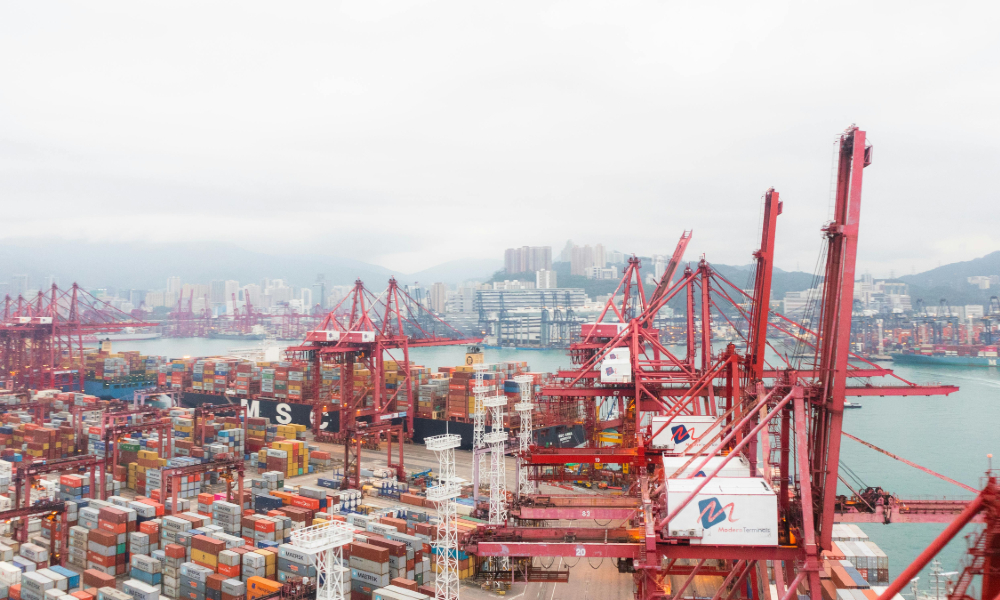The Shifting Landscape of U.S.-China Economic Relations

Published by The Lawfare Institute
in Cooperation With

Editor’s Note: The growing animosity between the United States and China is most visible in the economic realm, where tariffs, trade restrictions, and other tools are being used as part of an increasingly hostile competition. My Center for Strategic and International Studies colleagues Philip Luck and Richard Gray lay out the export controls and legal changes that Beijing is using to increase its ability to wage an economic war and argue that Washington’s recent policy decisions are undermining U.S. credibility.
Daniel Byman
***
A parallel transformation is underway in Beijing and Washington as both powers recalibrate the instruments of economic statecraft. The United States is adopting increasingly assertive, impromptu, and discretionary approaches, while China is transitioning to a system of economic restrictions predicated on legal doctrine. Unlike the previous era of economic integration under the Bretton Woods system, today’s convergence is driven by the mutual development of tools to exploit vulnerabilities.
China’s Formalization of Export Controls
On Oct. 17, 2020, China’s National People’s Congress passed the “PRC Export Control Law.” This law had two crucial objectives. First, the law streamlined the issuance and implementation of export controls, thereby formalizing coordination between the State Council, the Central Military Commission, and provincial governments. Second, it established a mandate for entities outside of China to comply with the country’s export control policy, stating that a violation of this law “endangers the national security and national interests of the People’s Republic of China, [and] hinders the performance of non-proliferation and other international obligations.”
American actions to throttle Huawei were arguably the primary impetus for the establishment of China’s export control regime. As visualizations from the International Institute for Strategic Studies demonstrate, the formalization of China’s economic statecraft measures has appeared to be largely reactive thus far. In August 2020, two months before Beijing enacted its Export Control Law, the U.S. Bureau of Industry and Security (BIS) expanded its restrictions on Huawei, blacklisting 38 affiliates and broadening the foreign direct product rule to block the firm’s access to critical technology. China’s Ministry of Commerce warned that “necessary measures” would be taken to protect the rights and interests of Chinese firms.
Since then, China has continued to formalize and refine its export controls regime. It expanded the Unreliable Entity List (prohibiting listed companies from trading with or investing in China), established licensing requirements for critical mineral exports, and banned the export of technology used in rare earth magnet manufacturing. Two days prior to China’s recent controls on gallium, germanium, and antimony exports to the United States, Premier Li Qiang signed a decree of the State Council to release new regulations on dual-use items, defining these items as “goods, technologies and services that may be used either for civil purposes or for military purposes or to contribute to an increase in military potential, especially to design, develop, produce or use weapons of mass destruction and their means of delivery.” As of Jan. 1, China required export licenses for 1,026 items (see Table 1).
Table 1. Categories of China's export licenses for dual-use items and technologies.
| Category of Restriction | Number of Restrictions |
| Export Control List of Dual-Use Items (including critical minerals, alloys, toxins, etc.) | 765 |
| Nuclear Export Control List | 159 |
| Precursor Chemicals | 61 |
| Precursor Chemicals (only restricted to specific countries) | 41 |
| Total | 1,026 |
Source: China’s Ministry of Commerce
China’s Legal Expansion: Beyond Export Controls
China’s push to formalize its economic restrictions is part of a broader effort to strengthen its foreign-related legal system. On Nov. 27, 2023, the Central Committee of the Chinese Communist Party convened its 10th session on this issue, where President Xi Jinping emphasized that legal reforms were essential for national rejuvenation and global influence. In the session, Xi remarked that:
Strengthening foreign-related rule of law is a long-term requirement for building China into a strong country and achieving national rejuvenation through a Chinese path to modernization. It is also an urgent task for advancing high-level opening up ... and [creating] favorable legal and external conditions for China's long-term and stable development.
From this transition in global power, the evolution of one country’s domestic law may lead to an evolution in international law. China seems particularly focused on positioning itself as safeguarding international law even if such positioning may introduce changes to that system. With Chinese firms internationalizing and China’s development projects crosscutting the globe, President Xi and Vice Chairman Wang Chen iterate that China ought to have contingencies in place to secure the interests of Chinese citizens, firms, and the nation. China believes that, without domestic and international legal reform, the nation’s rejuvenation and governmental modernization would be impeded.
China’s strategy to secure these interests has three key components. First, it is increasing legal scholar exchanges and investing in international arbitration centers to increase Beijing’s understanding of and engagement with other countries’ legal systems. Second, through laws like the Anti-Foreign Sanctions Law, China is increasingly asserting legal authority beyond its borders. And third, China is refining countermeasures—including national security reviews, antitrust regulations, and the Unreliable Entity List—to respond to foreign economic pressures.
Recent legal reforms reflect this strategy. In 2023, China amended its Civil Procedure Law to expand court jurisdiction over foreign-related disputes and clarify rules for recognizing and enforcing foreign judgments, strengthening its role in international dispute resolution. The Arbitration Law was also revised to formalize the framework for processing foreign-related disputes. As a result, China is expanding its legal footprint—China’s Ministry of Justice claims that it is establishing 180 overseas law offices and training 12,000 lawyers across 35 countries.
The Growing Burden on Third States
As both China and the United States are intent on expanding the extraterritorial enforcement, third countries are caught in the cross fire. In March, BIS Undersecretary Jeffrey Kessler said that the agency intends to increase export enforcement against China while reducing export control collaboration with allies. That same month, China’s State Council passed “Regulations on the Implementation of the Anti-Foreign Sanctions Law of the People's Republic of China,” which provides ministries:
The right to interview, order rectification, and take corresponding measures against those who implement or assist in the implementation of discriminatory restrictive measures taken by foreign countries against Chinese citizens or organizations.
For third states, compliance requirements from the United States and China are becoming more demanding and incompatible. Complying with U.S. export controls risks violation of China’s Anti-Foreign Sanctions Law, while adhering to China’s mandates could trigger U.S. countermeasures. Consequently, U.S. secondary sanctions will lose potency, with international companies having to weigh access to U.S. versus Chinese markets in their compliance strategies. As the U.S. and China continue to innovate and broaden their systems of controls, the challenge posed by not running afoul of either will become increasingly complex. Eventually, states and companies will have to choose with which set of export controls to comply.
The Growing Global Influence of China’s Legal Model
As China integrates its legal system with its economic strategy, it is also starting to affect governance models in the developing world. As legal scholar Matthew Erie argues, China’s significant economic footprint and its incipient “foreign-related rule of law” may, through means both intentional and unintended, lead to “integrat[ing] Chinese law into foreign and international law.”
Through the Belt and Road Initiative, China’s governance model may gain influence in tandem with its infrastructure projects. Through these projects, China offers a pathway for development that many semi- and non-democracies view as a viable alternative to Western liberal democracy. Host countries consult with Chinese legal scholars on the development of their legal systems, as seen in Cambodia’s Constitution, Uzbekistan’s Data Protection Law, and Vietnam’s Cybersecurity Law. And, through memoranda of understanding, China facilitates legal cross-pollination, leading countries to replicate its industrial policies, governance strategies, and digital ecosystem.
China’s legal influence is both organic and strategic. Given its sheer economic and political weight, it inevitably shapes global legal norms—whether through direct legal cooperation or the adoption of Chinese legal standards by countries seeking closer ties. As China formalizes its legal system, cooperates with aligned states on extraterritorial matters, and plays a leading role in nascent legal domains, including artificial intelligence, climate, and maritime, the global legal environment is becoming increasingly complex for the United States.
America’s Strategic Blind Spot
While China expands its legal and economic toolkit, the United States risks undermining its own influence. In its efforts to shutter institutions such as the U.S. Agency for International Development (USAID) and the U.S. Agency for Global Media, the Trump administration is eroding American soft power and undermining the credibility of the U.S. system of governance, making it appear increasingly arbitrary and capricious.
One of the principal objectives of USAID was to “support more stable, resilient, and democratic societies.” Across the world, USAID programs trained lawyers and empowered local leaders to reform their legal systems. In Georgia, the agency conducted a Rule of Law Program, providing lawyers with mediation and dispute resolution training. In Kyrgyzstan, the National Target Program for Development supported reforms for judicial independence and judicial training. And, in Indonesia, USAID assisted the Supreme Court’s strategic planning, increased statistical literacy for court staff, and improved the judiciary’s transparency and engagement with civil society. Now, that has all been curtailed.
When the Biden administration launched its first round of semiconductor export controls in 2022, it did so with the backing of Japan and the Netherlands. It is unclear that historical U.S. partners and allies will comply with future export controls. Currently, the United States is creating animus in trade and rhetoric with its closest allies, while threatening to close its market to some of the world’s fastest growing developing economies—countries that include Vietnam and India. The United States remains a dominant force in trade and technology, but it cannot enforce extraterritorial controls in isolation. In sectors like semiconductors, critical minerals, and pharmaceuticals, unilateral restrictions will be difficult, if not impossible, to sustain.
The current contest over export controls and legal systems is not merely about economics or national security. It is about competing governance models. While their capabilities remain asymmetrical, both the United States and China are developing rival systems that are increasingly incompatible.
In terms of U.S.-China statecraft, one thing is clear: We are entering a new phase of U.S.-China relations, defined by reciprocated efforts to outmaneuver politically, constrain economically, and mirror legally.




.jpeg?sfvrsn=c4bce09_7)
